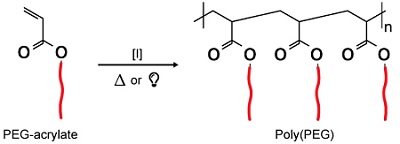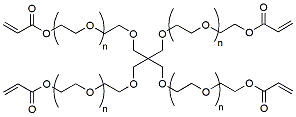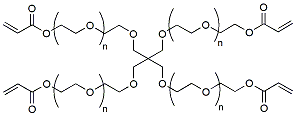|
Polymer PEG (Polydisperse PEG)
Polymer PEG is a Polyethylene glycol (PEG) polymer with an averaged molecular weight, such as 2K, 5K,
10K, 20K with PDI ranging from 1.01-1.10. Polymer PEG is also known as polydisperse PEG, or Poly-PEG.
There are different shapes of Polymer PEG, such as linear, Y-shaped, branched, or star shaped with
different PEG chain lengths as shown in Figure 1. PEG chain can be attached with different functional groups
for chemistry modification and industrial application.

Figure 1. Examples of Polymer PEG that are commercially available. Typical functional groups include
Acrylate, alkyne, Amine, Azide, DBCO, TCO, Aldehyde, Acid, NHS ester, Hydrazide, Maleimide, Silane,
Biotin, Tos, or Thiol.
Polymer PEG have become especially attractive tools in various pharmaceutical, biological and chemical
industry application due to its aqueous solubility, high flexibility and non-immunogenicity
Polymer PEG, Acrylate
PEG-acrylates contain vinyl groups (-CH=CH2) which can be used for radical polymerization with initiator
under heat or UV light. The common radical polymerizations include atom transfer radical polymerization
(ATRP), free radical polymerization (FRP), and reversible addition-fragmentation chain transfer (RAFT)
polymerization. PEG -acrylates can also be used for thiol-ene reaction in the presence of UV light.

Acrylate-PEG-acrylate
|
Catalog No.
|
Product Name
|
Size
|
|
Feature
|
|
Structure
|
|
BP-25704
|
Acrylate-PEG-acrylate, MW 3,400
|
1g & 5g
|
|
Acrylate-PEG-acrylate, MW 3,400 is a di-acrylate PEG polymer. This compound is very useful as a
crosslinking agent due to simple polymerization of the vinyl groups at both ends. The PEG chain helps with
water solublity and flexibilty of the crosslinking agent.
|
|

|
Acrylate-PEG-NH2
|
BP-22892
|
Acrylate-PEG-NH2, MW 2,000
|
500mg, 1g & 5g
|
|
Acrylate-PEG-NH2, MW 2,000 is a functionalized PEG containing both acrylate and amine group. Amine is
reactive with NHS esters or carboxylic acids in the presence of HATU or EDC. Acrylate group can be used
for radical or UV initiated polymerization or thiol-ene reaction via Michael Addition.
|
|

|
|
BP-22893
|
Acrylate-PEG-NH2, MW 10,000
|
1g & 5g
|
|
Acrylate-PEG-NH2, MW 10,000 is a functionalized PEG with vinyl moiety at one end and amine at the other
end. Acrylate is commonly used for radical polymerization. The amine group is reactive with carboxylic
acids and activated NHS esters.
|
|

|
Acrylate-PEG-OH
|
BP-22894
|
Acrylate-PEG-OH, MW 5,000
|
1g & 5g
|
|
Acrylate-PEG-OH, MW 5,000 is a PEG polymer containing an acrylate and hydroxyl group. Hydroxyl groups
is commonly modified to other functional groups such as alkyne and azide. The acrylate is easily
polymerized using radical initiator.
|
|

|
|
BP-22895
|
Acrylate-PEG-OH, MW 10,000
|
1g & 5g
|
|
Acrylate-PEG-OH, MW 10,000 is an acrylate functionalized PEG containing a hydroxyl group. Hydroxyl
groups is a reactive group that can be altered to form many funtional groups. The acrylate is easily
polymerized using radical initiator.
|
|

|
|
BP-22896
|
Acrylate-PEG-OH, MW 3,400
|
1g & 5g
|
|
Acrylate-PEG-OH, MW 3,400 is a polymerizeable PEG polymer containing hydroxyl group. The hydroxyl
group can be further chemically changed for bioconjugation, coupling, or click chemistry.
|
|

|
m-PEG-Acrylate
|
BP-25254
|
m-PEG-Acrylate, MW 1,000
|
1g, 5g & 10g
|
|
m-PEG-Acrylate, MW 1,000 is a polyPEG compound which can be readily polymerized in the presence of
radical initiator. The PEG chain of the acrylate polymer increases water solubility.
|
|

|
|
BP-22891
|
m-PEG-Acrylate, MW 2,000
|
1g, 5g & 10g
|
|
m-PEG-Acrylate, MW 2,000 is an acrylate polyPEG monomer. The vinyl group polymerizes in the presence
of radical (UV or heat) initiator. The PEG improves overall solubility of the molecule.
|
|

|
|
BP-22890
|
m-PEG-Acrylate, MW 10,000
|
1g, 5g & 10g
|
|
m-PEG-Acrylate, MW 10,000 is a polyPEG acrylate molecule for surface grafting of PEG polymer via radical
polymerization, such as ATRP or RAFT technique.
|
|

|
|
BP-22889
|
m-PEG-Acrylate, MW 20,000
|
1g, 5g & 10g
|
|
m-PEG-Acrylate, MW 20,000 is an acrylate polyPEG for preparing polymer brush on various surfaces via
radical polymerization technique, such as ATRP or RAFT.
|
|

|
|
BP-22888
|
m-PEG-Acrylate, MW 30,000
|
1g & 5g
|
|
m-PEG-Acrylate, MW 30K is a PEG acrylate monomer which can be polymerized to produce a brush type
structure on surfaces. The acrylate is also reactive to thiol via thiol-ene reaction by formation of a thioether
bond.
|
|

|
ACRL-PCL-PEG-ALK
|
BP-26475
|
ACRL-PCL(5k)-PEG(2k)-ALK
|
100mg
|
|
ACRL-PCL(5k)-PEG(2k)-ALK is an amphiphilic block copolymer (ABC) where the acrylate moiety is
tethered to polycaprolactone (PCL) while the alkyne group is chemically attached to the PEG. The alkyne is
reactive to azide molecule to form triazole bond while acrylate moiety can react with thiol via thiol-ene
reaction or can be polymerized via photo-polymerization. The ABC forms micelles in aqueous solution and
can be used to prepare nanoparticles for drug delivery.
|
|

|
|
BP-26476
|
ACRL-PCL(5k)-PEG(3.4k)-ALK
|
100mg
|
|
ACRL-PCL(5k)-PEG(3.4k)-ALK is an azide reactive amphiphilic block copolymer which can form micelles
for drug encapsulation in targeted delivery application. The acrylate moiety can react with thiol via thiol-ene
reaction or can be polymerized via photo-polymerization.
|
|

|
4 arm-PEG-ACRL
|
BP-25163
|
4 arm-PEG-ACRL, MW 10,000
|
1g, 2g & 5g
|
|
4 arm-PEG-ACRL, MW 10,000 is a PEG polymer with acrylate at each terminal of the four arms connected to
one pentaerythritol core. The acrylate group can be used in radical polymerization or thiol-ene reaction.
|
|

|
|
BP-25164
|
4 arm-PEG-ACRL, MW 20,000
|
1g, 2g & 5g
|
|
4 arm-PEG-ACRL, MW 20,000 is a pentaerythritol core 4 arms PEG with terminal acrylate groupw which can
be polymerized using radical or UV initiator.
|
|

|
|















